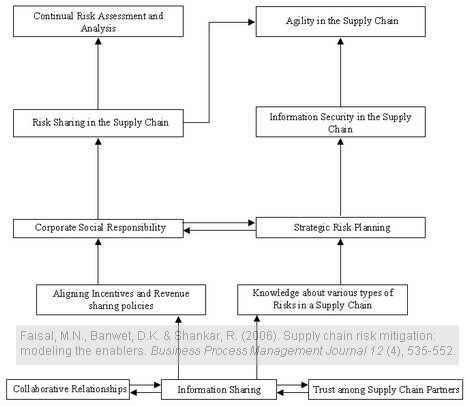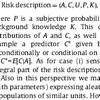 My latest acquaintance in supply chain risk research methodology is developing drivers and dependants using interpretive structural modelling (ISM). A good example was provided by the trio of Mohd Nishat Faisal, D.K. Banwet, and Ravi Shankar, which I presented last week when I reviewed their paper on information risks management. As I found out, they used ISM in a previous paper written a year earlier, Supply chain risk mitigation: modeling the enablers, looking specifically (or perhaps more generally) at enablers of supply chain risk mitigation. Again, a fascinating article…
My latest acquaintance in supply chain risk research methodology is developing drivers and dependants using interpretive structural modelling (ISM). A good example was provided by the trio of Mohd Nishat Faisal, D.K. Banwet, and Ravi Shankar, which I presented last week when I reviewed their paper on information risks management. As I found out, they used ISM in a previous paper written a year earlier, Supply chain risk mitigation: modeling the enablers, looking specifically (or perhaps more generally) at enablers of supply chain risk mitigation. Again, a fascinating article…
Interpretive structural modeling
Interpretive structural modelling (ISM) can be used for identifying and summarizing relationships among specific variables, also called “enablers”. ISM provides a means by which order and relationships can be imposed on such variables, thus categorizing the enablers according to their driving power and dependence.
Enablers of risk mitigation
Based on a solid literature review the authors come up with 11 enablers:
- Information sharing
- More information means more visibility means less surprises
- Supply chain agility
- Agility allows for faster adapting to changing circumstances without losing momentum
- Trust among supply chain partners
- Lack of trust creates opportunism only
- Collaborative relationships among supply chain partners
- Collaboration creates interdepence and the appreciation of flexibility and responsiveness
- Information security
- Information is the most critical asset in the chain, so guard it
- Corporate social responsibility
- Be prepared to manage the consequences of partners’ (wrong) policies
- Aligning of incentives and revenue sharing policies
- Everybody’s interest must be served, not just one’s own
- Strategic risk planning
- The supply chain is a strategic asset, not just an operational necessity
- Risk sharing
- Both risks and rewards need to be distributed evenly throughout he chain
- Knowledge about risks in the supply chain
- Risk understanding improves decision-making
- Continuous risk analysis and assessment
- Business environments are dynamic, so are the risks
I cannot think of anything else, can you?
Dependant versus driver matrix
Similar to the later article on information risks management, the authors end up with a matrix showing the interrelations among the enablers, based on their dependency and driving power.


The enablers are further classified as
(1) Autonomous enablers (Southwest quadrant)
(2) Dependent enablers (Southeast quadrant)
(3) Linkage enablers (Northeast quadrant)
(4) Independent enablers (Northwest quadrant)
Autonomous enablers have a weak driver power and weak dependence. These enablers are relatively disconnected from the system. Linkage variables work both ways; they affect the enablers above and are at the same time dependent on the enablers below. Independent variables have a strong driver power and weak dependence. Dependent enablers are dependent on the other variables.
Conclusion
Interestingly, in this paper, the dependent enablers with the least driving force are seen as key enablers, while in the paper on information risks, the independent enablers are seen as the strongest contributors towards risk mitigation. Confusing at first, perhaps, but it depends on your point of view. Most important however, is that the interpreted structural modelling methodology, as the name implies, only provides the framework for interpretation of supply chain risk mitigation. It does not provide the answer.
Reference
Faisal, M., Banwet, D., & Shankar, R. (2006). Supply chain risk mitigation: modeling the enablers. Business Process Management Journal, 12 (4), 535-552 DOI: 10.1108/14637150610678113
Author links
- qu.edu: Mohd Nishat Faisal
- dmsiitd.org: D.K. Banwet
- dmsiitd.org: Ravi Shankar
Related
- husdal.com: Information risks management
- husdal.com: Supply Chain Confidence
- husdal.com: Corporate vulnerability












